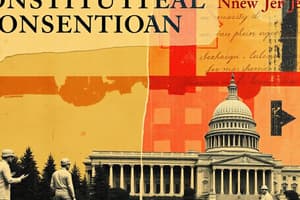Podcast
Questions and Answers
What did the Virginia Plan propose?
What did the Virginia Plan propose?
- A new government with 3 separate branches (correct)
- Limited powers to tax and regulate trade
- A unicameral legislature
- No executive branch
What is the New Jersey Plan?
What is the New Jersey Plan?
A proposal that added limited powers to tax and regulate trade between states.
What did the Connecticut Compromise propose?
What did the Connecticut Compromise propose?
- One legislative body
- A monarchy
- No compromise at all
- Two houses in Congress (correct)
How should slaves be counted according to the Three-Fifths Compromise?
How should slaves be counted according to the Three-Fifths Compromise?
What restriction did the Commerce and Slave Trade Compromise impose?
What restriction did the Commerce and Slave Trade Compromise impose?
Name a group whose interests seem to have been ignored by the compromises that created the Constitution.
Name a group whose interests seem to have been ignored by the compromises that created the Constitution.
What are framers?
What are framers?
Flashcards are hidden until you start studying
Study Notes
Virginia Plan
- Proposed a new government structure with three separate branches: legislative, executive, and judicial.
- Congress would select national legislative and executive powers, which could veto passed acts.
- Favored by larger states due to proportional representation based on population.
New Jersey Plan
- Advocated for a revision of the Articles of Confederation rather than a complete overhaul.
- Proposed limited powers for the federal government to tax and regulate interstate commerce.
- Included a federal executive and a judiciary, with a supreme tribunal for legal matters.
- Supported by smaller states seeking equal representation regardless of population.
Connecticut Compromise
- Combined elements from both the Virginia and New Jersey Plans.
- Established a bicameral legislature with two houses: the Senate (equal representation) and the House of Representatives (proportional representation).
- Aimed to balance the interests of both large and small states in governance.
Three-Fifths Compromise
- Determined that slaves would be counted as three-fifths of a person for representation and taxation purposes.
- Attempted to address concerns from southern states regarding population counts to determine legislative representation.
Commerce and Slave Trade Compromise
- Congress prohibited from taxing the export of goods from any state.
- Delayed and restricted federal intervention in the slave trade for a set number of years.
- Acknowledged the importance of trade to southern economies while appeasing concerns over slavery.
Impact on Slaves and African Americans
- Interests of slaves and African Americans largely disregarded in constitutional compromises.
- The compromises facilitated the continuation of slavery and limited rights for these groups.
Framers
- Group of delegates at the Philadelphia Convention responsible for drafting the U.S. Constitution.
- Represented various states and interests, with some compromises favoring certain states over others.
Studying That Suits You
Use AI to generate personalized quizzes and flashcards to suit your learning preferences.




